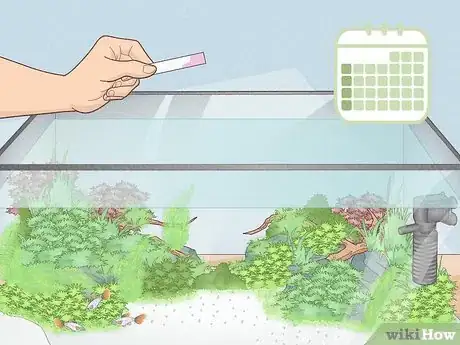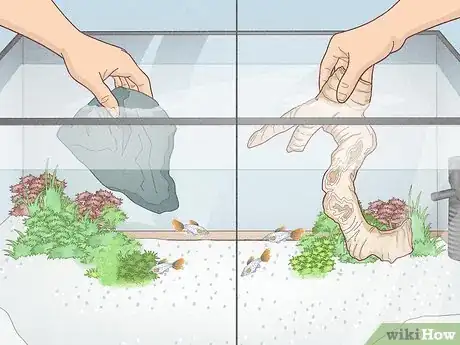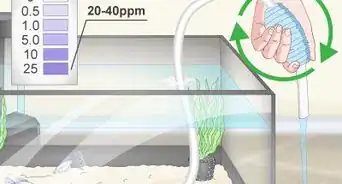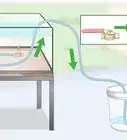This article was co-authored by Doug Ludemann and by wikiHow staff writer, Eric McClure. Doug Ludemann is the owner and operator of Fish Geeks, LLC, an aquarium services company based in Minneapolis, Minnesota. Doug has worked in the aquarium and fish-care industry for over 20 years, including having worked as a professional aquarist for the Minnesota Zoo and Shedd Aquarium in Chicago. He received his Bachelor of Science in Ecology, Evolution, and Behavior from the University of Minnesota.
There are 11 references cited in this article, which can be found at the bottom of the page.
This article has been viewed 146,524 times.
Your fish tank’s pH level refers to how acidic or basic the water is. Testing the pH in your fish tank is one of the most important elements of keeping a clean and healthy environment for your fish.[1] But don't worry—this isn’t nearly as much work as it might seem, and with a little forethought and research, your fish will be on the road to live long and prosper!
Steps
How do I use a store-bought kit to test the pH in a fish tank?
-
1Purchase a pH testing kit and follow the instructions. There are a few different kinds of kits out there, but the two main options are the test tube kits, and the strip tests. The test tubes tend to be more accurate, but they’re both reasonable options.[3]
- The strip tests are a little easier to use, but most aquarium enthusiasts find the test tube version of the test to be more accurate.
- There are digital meters out there as well—you just stick a probe in the water and get a reading. If you plan on testing the water regularly, these can be a good investment! They do tend to be a lot more expensive, though. A testing kit will only cost $10-20, but the accurate digital meters can be $50-100.
-
2Scoop some water up if you have a test tube kit. Wash your hands to avoid any contaminants and scoop up a little bit of tank water in the vial that came with your kit. Pour in 3-5 drops of the testing solution per the instructions of your kit and shake the tube up. Once the water changes color, compare it to the color-coded reference chart that came with the kit to determine the pH of the water.[4]
-
3Put the paper directly in the water if you have a strip test. Grab one of your testing strips and stick half of it into the tank water. Slide it back and forth in the water or hold the strip steady depending on the instructions. Then, pull the strip out of the water and wait for it to start changing color. Once the color stops changing, compare the strip to the reference chart that came with your kit to find the pH.[5]
- One of the benefits of these strip tests is that they often include color-coded readings for ammonia, nitrates, and other nutrients as well. However, a lot of aquarium hobbyists find these strips to be kind of unreliable.
How do I adjust the pH in my fish tank?
-
1If it’s too low, change your water more often and add rocks or shells. Cycling or changing your tank’s water will reset the pH level to bring it back up to a more neutral level. You can also add aquarium-safe rocks or shells to the tank to naturally raise the pH in a stable and efficient way.[8]
- You can also add 1 teaspoon (4.9 mL) of baking soda for every 5 gallons (19 L) of water to artificially raise the pH, but it can be kind of difficult to make sure you aren’t adding too much and it’s better to fix this problem by changing the water or adding things to the tank.
-
2Try adding driftwood or peat moss to lower the pH if it’s too high. Driftwood is a particularly elegant solution since it promotes the growth of a variety of beneficial bacteria. You can also add peat moss to the tank to naturally lower the pH. You can either filter the aquarium water with peat moss before adding it to your aquarium, or use it as a substrate.[9]
- There are chemicals you can buy to lower the pH artificially, but it can be exceptionally difficult to keep the pH at a stable level if you have to keep adding chemicals.
Expert Q&A
Did you know you can get premium answers for this article?
Unlock premium answers by supporting wikiHow
-
QuestionHow do pH levels effect the health of my fish?
 Doug LudemannDoug Ludemann is the owner and operator of Fish Geeks, LLC, an aquarium services company based in Minneapolis, Minnesota. Doug has worked in the aquarium and fish-care industry for over 20 years, including having worked as a professional aquarist for the Minnesota Zoo and Shedd Aquarium in Chicago. He received his Bachelor of Science in Ecology, Evolution, and Behavior from the University of Minnesota.
Doug LudemannDoug Ludemann is the owner and operator of Fish Geeks, LLC, an aquarium services company based in Minneapolis, Minnesota. Doug has worked in the aquarium and fish-care industry for over 20 years, including having worked as a professional aquarist for the Minnesota Zoo and Shedd Aquarium in Chicago. He received his Bachelor of Science in Ecology, Evolution, and Behavior from the University of Minnesota.
Professional Aquarist
-
QuestionWhat is the best pH level for catfish and tilapia fish?
 wikiHow Staff EditorThis answer was written by one of our trained team of researchers who validated it for accuracy and comprehensiveness.
wikiHow Staff EditorThis answer was written by one of our trained team of researchers who validated it for accuracy and comprehensiveness.
Staff Answer wikiHow Staff EditorStaff Answer
wikiHow Staff EditorStaff Answer -
QuestionHow can I increase the pH of my fish tank?
 Community AnswerOne teaspoon of baking soda per five gallons is generally a safe amount for small, incremental increases. It's best to remove the fish from the tank prior to raising the pH. Then simply dissolve the required amount of baking soda in some conditioned water and add it to the aquarium.
Community AnswerOne teaspoon of baking soda per five gallons is generally a safe amount for small, incremental increases. It's best to remove the fish from the tank prior to raising the pH. Then simply dissolve the required amount of baking soda in some conditioned water and add it to the aquarium.
References
- ↑ Doug Ludemann. Aquarium Care Professional. Expert Interview. 27 August 2019.
- ↑ https://www.fdacs.gov/Consumer-Resources/Recreation-and-Leisure/Aquarium-Fish/Aquarium-Water-Quality-pH
- ↑ https://fishlab.com/aquarium-test-strips/
- ↑ https://youtu.be/TdrKCladJmA?t=104
- ↑ https://youtu.be/gsu3dny6amQ?t=417
- ↑ https://www.fdacs.gov/Consumer-Resources/Recreation-and-Leisure/Aquarium-Fish/Aquarium-Water-Quality-pH
- ↑ https://www.petmd.com/fish/care/evr_fi_how-to-clean-fish-tank
- ↑ https://www.ratemyfishtank.com/blog/properly-maintaining-the-ph-in-a-freshwater-aquarium
- ↑ https://www.ratemyfishtank.com/blog/properly-maintaining-the-ph-in-a-freshwater-aquarium
- ↑ https://fishtankadvisor.com/natural-ph-control/
- ↑ https://www.jstor.org/stable/25562204?seq=1
- ↑ https://waterfiltercast.com/how-to-test-ph-of-water-without-a-kit/
- ↑ https://www.ratemyfishtank.com/blog/properly-maintaining-the-ph-in-a-freshwater-aquarium
- ↑ https://users.cs.duke.edu/~narten/faq/chemistry.html
About This Article
To test pH in a fish tank, start by looking up the desired pH for your aquarium online since different kinds of fish have different pH requirements. However, in general, you should aim for 8.0 to 8.3 in a saltwater tank and 5.5 to 7.5 in a freshwater tank. Once you know what pH level your tank should be at, test it using a chemical or digital pH tester, which you can buy online or at your local pet store. If the pH level in your tank is off, you may need to add solutions or conditioners to stabilize it. For advice on how to choose a pH tester, read on!

































































